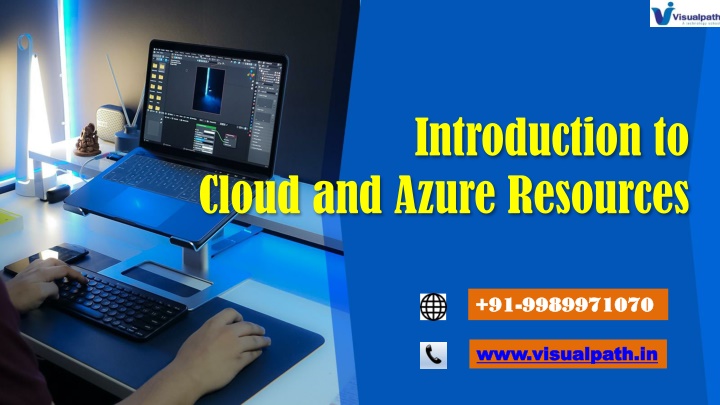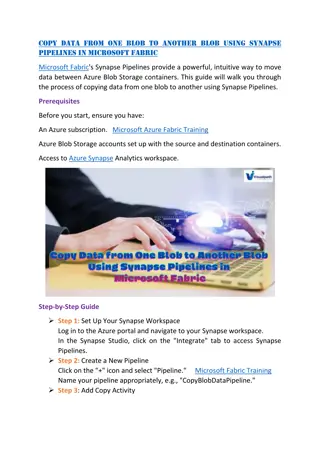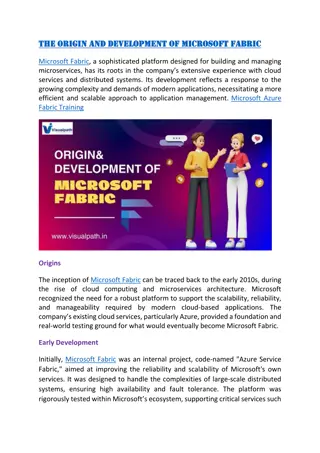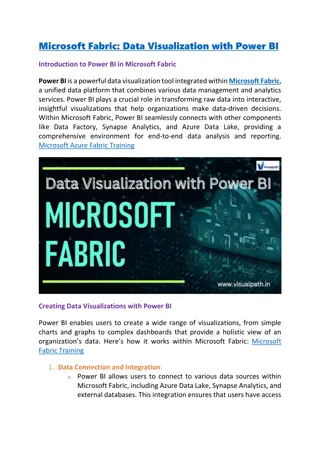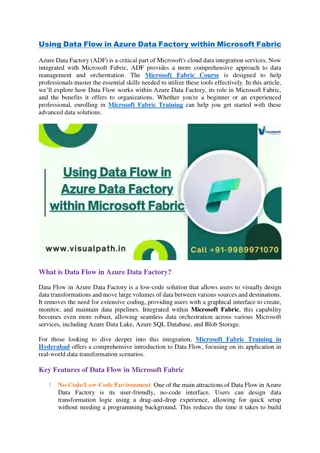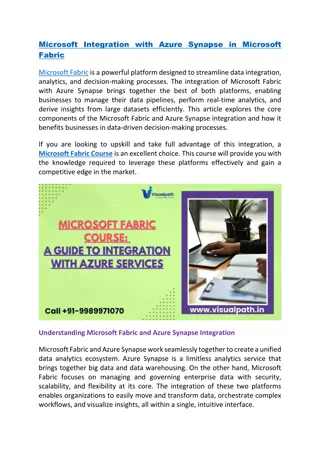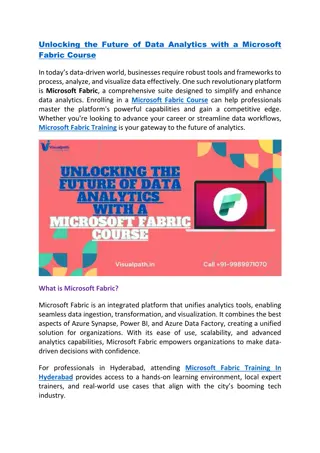Microsoft Fabric Online Training Course | Microsoft Fabric Online Training
nMicrosoft Fabric Training - Visualpath provides top-quality Microsoft Fabric Online Training conducted by real-time experts. Our training is available worldwide, and we offer daily recordings and presentations for reference. Call us at 91-9989971070 for a free demo.nWhatsApp: // /catalog/919989971070nVisit: // /microsoft-fabric-online-training-hyderabad.html
Download Presentation

Please find below an Image/Link to download the presentation.
The content on the website is provided AS IS for your information and personal use only. It may not be sold, licensed, or shared on other websites without obtaining consent from the author.If you encounter any issues during the download, it is possible that the publisher has removed the file from their server.
You are allowed to download the files provided on this website for personal or commercial use, subject to the condition that they are used lawfully. All files are the property of their respective owners.
The content on the website is provided AS IS for your information and personal use only. It may not be sold, licensed, or shared on other websites without obtaining consent from the author.
E N D
Presentation Transcript
Introduction to Cloud and Azure Resources +91 +91- -9989971070 9989971070 www.visualpath.in www.visualpath.in
What is Cloud Computing? Definition: Cloud computing refers to the delivery of computing services including databases, networking, software, and analytics over the internet ("the cloud"). Key Characteristics: On-demand self-service, broad network access, resource pooling, rapid elasticity, and measured service. Benefits: Scalability, flexibility, reliability, and accessibility. servers, storage, cost-effectiveness, www.visualpath.in
Types of Cloud Computing Public Cloud: Services provided by third-party providers over the internet, accessible to anyone. Private Cloud: Cloud infrastructure exclusively for a single organization, hosted either on- premises or by a third-party provider. Hybrid Cloud: Combination of public and private cloud environments, enabling data and application portability and flexibility. www.visualpath.in
Introduction to Azure What is Azure: Microsoft Azure is a cloud computing platform and services offered by Microsoft. Key Features: Infrastructure as a Service (IaaS), Platform as a Service (PaaS), and Software as a Service (SaaS). Azure Services: Compute, Databases, Artificial Intelligence, Internet of Things, DevOps, and more. Storage, Networking, www.visualpath.in
Core Azure Resources Compute: Virtual Machines, Azure App Service, Azure Functions. Storage: Blob Storage, File Storage, Table Storage, Queue Storage. Networking: Virtual Balancer, VPN Gateway, Azure DNS. Databases: Azure SQL Database, Cosmos DB, Azure Database for MySQL, Azure Database for PostgreSQL. Network, Load www.visualpath.in
Azure Resource Management Azure Portal: Web-based interface for managing Azure resources and services. Azure Resource Manager management service that enables you to provision, manage, and organize resources in Azure. Resource Groups: Logical containers that group related Azure resources for easier management, security, and billing. (ARM): Infrastructure www.visualpath.in
Benefits of Azure Scalability: Scale resources up or down based on demand, ensuring optimal performance and cost-effectiveness. Security: Robust security compliance certifications to protect data and applications. Integration: Seamless integration with other Microsoft products and services, as well as third- party tools and platforms. Global Presence: Azure data centers located worldwide, enabling low-latency access and compliance with data sovereignty requirements. features and www.visualpath.in
Conclusion In conclusion, we've explored the fundamentals of cloud computing and gained insight into the diverse range of Azure resources available on Microsoft's cloud platform. Cloud computing offers unparalleled scalability, flexibility, and accessibility, empowering organizations to innovate and adapt to evolving business needs. www.visualpath.in
Azure, as a leading cloud provider, offers a comprehensive suite of services spanning compute, storage, networking, databases, artificial intelligence, and more. With Azure, organizations can build, deploy, and manage applications with ease, leveraging cutting- edge technology to drive digital transformation and achieve business objectives. www.visualpath.in
As we conclude, it's essential to recognize the transformative potential of cloud computing and Azure resources in modern IT environments. By embracing cloud technology and leveraging Azure's capabilities, organizations can unlock new opportunities, enhance efficiency, and accelerate innovation in today's dynamic business landscape. www.visualpath.in
CONTACT Microsoft Fabric Microsoft Fabric OnlineTraining Address:- Flat no: 205, 2nd Floor Nilagiri Block, Aditya Enclave, Ameerpet, Hyderabad-16 Ph No : +91-9989971070 Visit : www.visualpath.in E-Mail : online@visualpath.in OnlineTraining
THANK YOU Visit: www.visualpath.in
